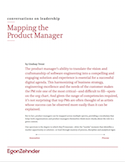The product manager’s ability to translate the vision and craftsmanship of software engineering into a compelling and engaging solution and experience is essential for a successful digital agenda. This harmonizing of business strategy, engineering excellence and the needs of the customer makes the PM role one of the most critical—and difficult to fill—spots on the org chart. And given the range of competencies required, it’s not surprising that top PMs are often thought of as artists whose success can be observed more easily than it can be explained.
But in fact, product managers can be mapped across multiple spectra, providing a vocabulary that helps both organizations and product managers themselves think more clearly about the role in a given context.
One spectrum is the degree to which they’ll innovate—drive the “eureka” moment that identifies a market opportunity or solution—or lead through mastery of process, discipline and analytical rigor.

PMs at the innovation end are often entrepreneurs and founders; they have the ability to generate insights and make them a reality. They often exhibit curiosity, challenge assumptions, and demonstrate tenacity in testing or proving hypotheses. Those who spike on process are those who excel at reaching alignment on trade-offs and ensuring production schedules and product delivery deadlines are met. To oversimplify the extremities of the spectrum, innovators are often oriented toward what while processors are often oriented on how.
The second spectrum reflects depth of technical acumen:

At one end, the marketing-oriented PM is a matchmaker between the product and its users, attuned to requirements, use cases and the overall user experience. For the engineering PM, on the other hand, the product and the elegance of its architecture stand on its own—if you build it, the consumer will follow. Again, on this spectrum, marketing-oriented individuals will focus more on what, while those who are engineering-oriented will focus on how. But regardless of where a PM sits between the two endpoints, he or she must effectively collaborate with engineering and have an appreciation for the art and science involved in the development of digital products.
A third spectrum categorizes PMs by product user type:

This is a spectrum in transition. While many PMs will come up through either enterprise or consumer, some will have worked on both types of products. With people increasingly expecting digital products at work to have the same usability as the digital products they use at home, and with many of those consumer products being driven by an underlying business-to-business proposition (e.g., advertising, marketplace e-commerce), the number of PMs with a blended experience will increase. Even so, the background of many PMs will lean one way or the other, with the corresponding orientation toward issues like life cycle management and distribution.
There is no optimal combination of Product Manager traits. The important thing is to find the right talent for the company, its stage, its team and its product. These frameworks allow us to conceptualize the relative strengths of talent and guide selection to ensure that proper fit.






